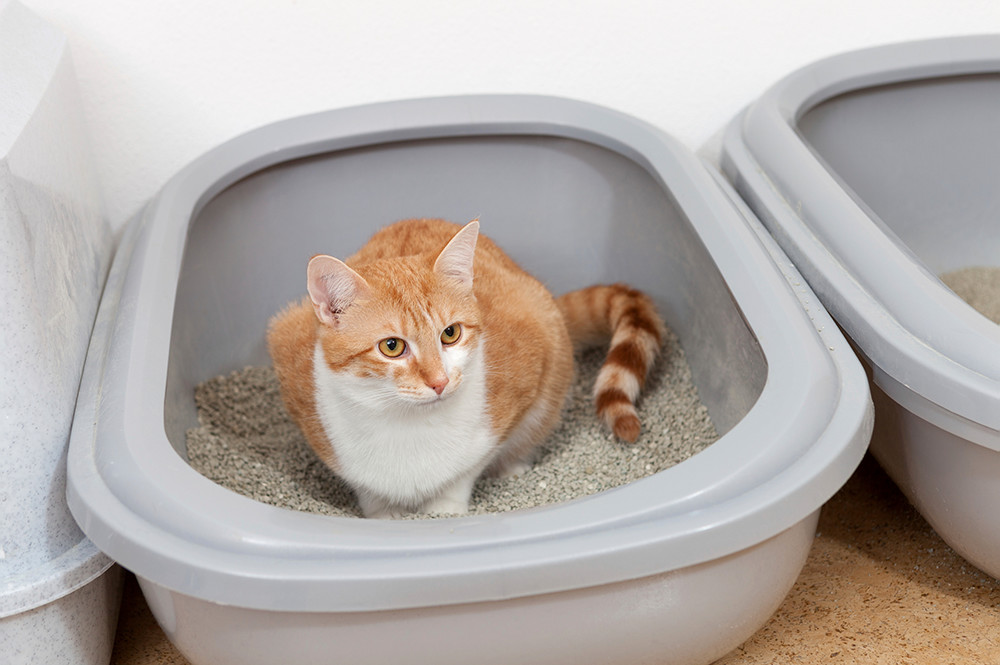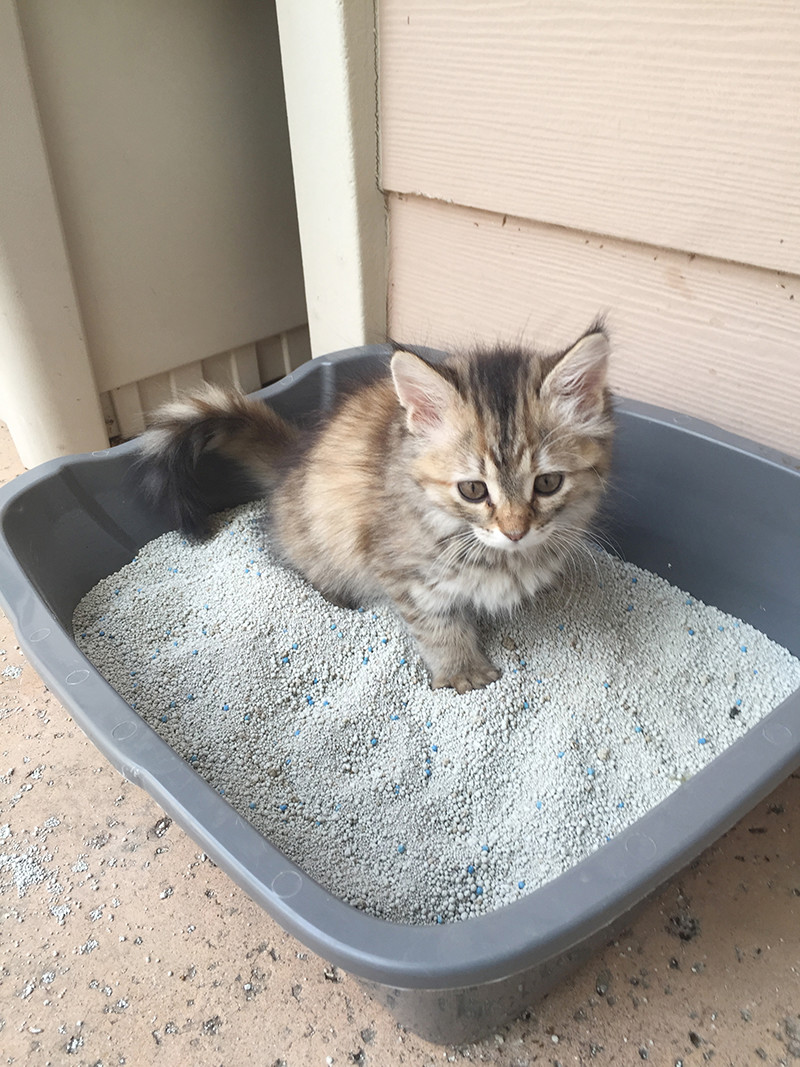Cat Clinic of Iowa City
Litter Box Care from Cat Clinic of Iowa City
Taking care of your cat’s litter box can be confusing. Read this helpful guide to help you through caring for your furry friend’s litter box.
Educational Care Guides
Make caring for your cat easy!
The First Litter Box Rule is: Cats cannot be litter trained. Cats usually use litter boxes because they prefer them and it is the best option. However, if the litter box is not to your cat’s liking, he/she will find another (and better) option (in his/her mind). We need to keep the litter boxes and the area around them as pleasant as possible or your cat will choose another location.

Number of Litter Boxes
The number of litter boxes that you need in your home depends on five conditions: number of cats; age of cats; size of house; number of floors of house; and any disorders your cat(s) may have. The answer is almost always: More than two. You’ll need:
- At least one litter box per cat
- At least one litter box per floor of home, or if you have a large flat, one at each end of home
- Extra litter boxes for younger (less than 4 months) and older cats (older than 8-10 years ) who have less bladder and bowel control
- Extra litter boxes for cats with history of urinary track infections or crystals, urinating/defecating outside the box, diabetes, kidney disease, irritable bowel syndrome or intestinal parasites, arthritis or orthopedic problems (see Size and Style)
Most homes need 2 boxes on the floor where the cat(s) spend most of their time, and 1 litter box for each other floor the cat(s) have access to. Generally you will have 1 or 2 large litter boxes with smaller boxes throughout the house.
Location of the Litter Boxes
This is the trickiest part. Litter boxes need to be in an area that is quiet and out of the flow of traffic, convenient for the cat, yet not bothersome to us. Also, keeping the litter boxes in an area where we can see them, gives us the added benefit of monitoring our cat’s bathroom habits and perhaps being able to catch problems earlier.
Locations that are generally favorable are: bathrooms, spare rooms, closets that can be left open, porches, even a bedroom. It can be difficult to put a litter box in a room that you use, and we will discuss how to cleverly “hide the boxes.” All areas you choose for the boxes, must be quiet, out of the flow of traffic, and away from things that might surprise or startle your cat. Do not put the litter box in a room where equipment or appliances (water heater, washer, dryer) may start or stop suddenly. If your cat is scared by anything near the litter box, he/she may never use it again. Litter boxes should not be placed where your cat needs to jump to, or travel far to get to the box. The cat will be less likely to use the litter box and you are less likely to keep it clean if it is too far out of the way. Litter boxes near windows can also spell trouble for shy cats as they may see animals outside that frighten them.

- Create a “ shower curtain” around boxes that are under tables or open sinks
- Purchase a special cat play area that has a litter box hide-away
- Place the box in a discrete corner behind a door or furniture
- Purchase a cat size “privacy folding screen”
To keep your cat from tracking litter onto the floor, place rugs on all sides of the box. The most effective type of mats have rubber backing and long fibers on top such as welcome or bath mats. If you place a box in a corner or next to a wall, we suggest placing a mat along the wall so that it is one to two feet up the wall. This is to catch urine or stool in case your cat “misses.”
Size and Style of Litter Boxes
Most cats prefer large litter boxes in which they have plenty of room. Litter boxes should have relatively short sides, ideally so that cats can simply step into them without having to jump. However, if your cat urinates near the edge of the box and will sometimes “miss.” A taller sided box will help. No box should have sides over 8 inches.
If you have a younger or senior cat, or a cat with orthopedic or other problems, you will need special boxes. These boxes should have at least 1 side that is lower (to about 2 inches). The bottom half of a covered litter box may work well in a small area, or purchase a larger box and cut a side down to size.
Most cats do not like litter box liners. Though they are convenient for us, if your cat is showing poor litter box behaviors, we would recommend not using them.
Self-cleaning litter boxes are not recommended for 3 reasons: 1) they may go off unexpectedly; 2) they do not adequately remove soiled litter; 3) and must be disassembled weekly for thorough cleaning.
Type of Litter
You must find the type of litter that works best for you and your cat. Regardless of the type of litter your cat chooses, most cats prefer about 2 inches of litter in the box.
In general, dusty litters are less favorable as they can irritate your cat’s sinuses and can pose a health risk to humans. Cats tend to prefer softer litter as it is easier for them to stand on. Soiled litter is more difficult to clean out from non-clumping litter. With clumping litter, it is difficult to determine what is urine and what is diarrhea. Most cats do not like added perfumes as they can be irritating to the nose.
Litter to look for: 1)clumping, 2)dust free, 3)perfume free, and 4)soft to the touch. The most important concern regarding choosing a litter is whether or not your cat likes it. Cost of litter and the inconvenience of having to purchase it at a pet store can challenging, but when placed against your feline friend urinating on the carpet, the cost and inconvenience are minimal.

Cleaning the Litter Boxes
Soiled litter, both urine and stool should be removed from all litter boxes in the house at least once daily. More frequently for multiple cats.
Litter in boxes should be dumped out at least weekly, and each box should be thoroughly scrubbed with disinfectant and rinsed well.
Plastic litter boxes should be replaced every 6 months to 1 year, glass and metal, every 1-2 years.
Health Risks with Litter Boxes
While you are maintaining your cat’s litter box, it is important to keep your safety in mind:
- Dusty litter can threaten your health, wear a mask as needed.
- Pregnant women should NEVER clean litter boxes due to risk of toxoplasmosis.
- Always wash your hands immediately after handling litter or cleaning as most intestinal parasites and many bacterial diseases are spread through stool.
Final Thoughts
So with all this information, now do you know if your cat doesn’t like the box or area? Cats who are not afraid of and like their boxes will spend time scratching and looking for just the right spot. Your cat should not express any anxiety while in the box. Your cat will also be able to get to the box in time without having to “hold it.” Getting and keeping your cat to consistently use the litter boxes begins with good litter box maintenance.
Remember: Cats do not become “litter trained.” They will choose to use the litter box if it is the best option. Bottom line: Does your cat like the type of litter and type of box, are there enough boxes, can your cat easily get to the boxes, and are they cleaned frequently? Litter box maintenance is a necessary component of ownership, and though it may not be our favorite part, it is a very important part.
